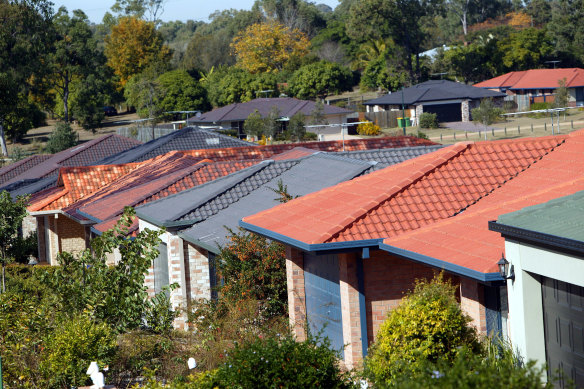This was published 4 months ago
RBA says not to expect rate cuts soon and can’t rule out a recession
By Shane Wright and Millie Muroi
Further interest rate pain for home buyers and businesses appears over after the Reserve Bank revealed it had not considered another hike and governor Michele Bullock admitted there was no guarantee the country could avoid a recession.
Following a two-day board meeting in Sydney, the RBA on Tuesday kept interest rates at 4.35 per cent – marking 10 months since the last rate rise and nearly four years since the last rate cut.

No relief … the RBA left rates at 4.35 per cent.Credit: Robert Rough
In a statement, the bank board said it was still not ruling “anything in or out” but Bullock said it did not explicitly consider a rate rise at this week’s meeting.
“So we didn’t explicitly consider an interest rate rise at this meeting,” she said. “The way we framed the discussion, really, was around what has changed since August, and what we would need to see to go raising interest rates or lowering interest rates.”
It’s the first time since the bank moved away from monthly meetings at the start of the year that it has not discussed a rate rise.
Financial markets reacted immediately to the governor’s comments, with interest rates on Australian government debt falling while the dollar shed almost half a cent against the American greenback.
Markets now put the chance of a rate cut at the RBA’s December meeting at 88 per cent. By the bank’s February meeting, markets fully expect the cash rate to be at 4.1 per cent.
While Bullock warned interest rate cuts were unlikely in the near term, saying they were “on hold for the time being”, she conceded the economy was struggling.
“Certainly we are aiming not to end up in recession,” she said. “That’s not what we’re aiming for. Could I guarantee it? No.”
Bullock said the bank’s forecasts did not have the economy entering recession at the moment but that there were “very wide bands” further out in the forecasts which indicated a wider margin for error.
“You only have to look at the forecast errors to see I can’t guarantee anything,” she said.
Monthly inflation data to be released on Wednesday is expected to show a steep fall in the annual inflation rate to around 2.7 per cent. The RBA cautioned this figure would likely be low because of government subsidies for energy, saying it was more focused on underlying inflation pressures.
Treasurer Jim Chalmers said the government’s policies were “helping, not hurting” the fight against inflation, which he said was now half of its peak from two years ago.
“Interest rates haven’t gone up for the best part of the year and this reflects the progress that we’ve made when it comes to getting inflation down,” he said in Toowoomba.
Chalmers said higher rate settings were “slowing our economy quite dramatically” but refrained from criticising the RBA’s decision to leave rates on hold, stressing he respected its independence.
Shadow treasurer Angus Taylor said Australia was at the “back of the pack” among its global peers on fighting inflation and bringing down interest rates.
“The government is attempting to manipulate headline inflation and the Reserve Bank is seeing straight through government manipulation,” he said. “The government needs to focus on doing the real job, which is to bring core inflation down so that interest rates can come down.”
The RBA has been caught by surprise by the weakness in household spending, which accounts for more than half of all economic activity.
In its statement, the bank board noted that while it expected a lift in consumer spending through the second half of this year there was a risk this may not eventuate which in turn would lead to a “sharper deterioration” in the jobs market.
The Commonwealth Bank’s head of Australian economics, Gareth Aird, said this suggested the RBA believes the stage 3 tax cuts – that began from July 1 – may not generate the lift in consumer expenditure it had been expecting.
“We don’t expect the tax cuts to generate a behavioural change in consumer spending. As a result, we think the RBA’s forecast profile for household consumption is too optimistic,” he said.
AMP chief economist Shane Oliver said February appeared the most likely for the Reserve’s first interest rate cut but it could be earlier if unemployment lifted, inflation fell sharply or there was a financial shock.
However, he said the bank should follow the lead of the US Federal Reserve which cut interest rates half a percentage point last week, noting the lag with which monetary policy hits the economy and the risk of much higher unemployment and inflation falling below target.
“In terms of what the RBA should do, as opposed to what we think it will do, given the US experience, it should now be starting to give consideration to a cut in interest rates,” he said.
Cut through the noise of federal politics with news, views and expert analysis. Subscribers can sign up to our weekly Inside Politics newsletter.